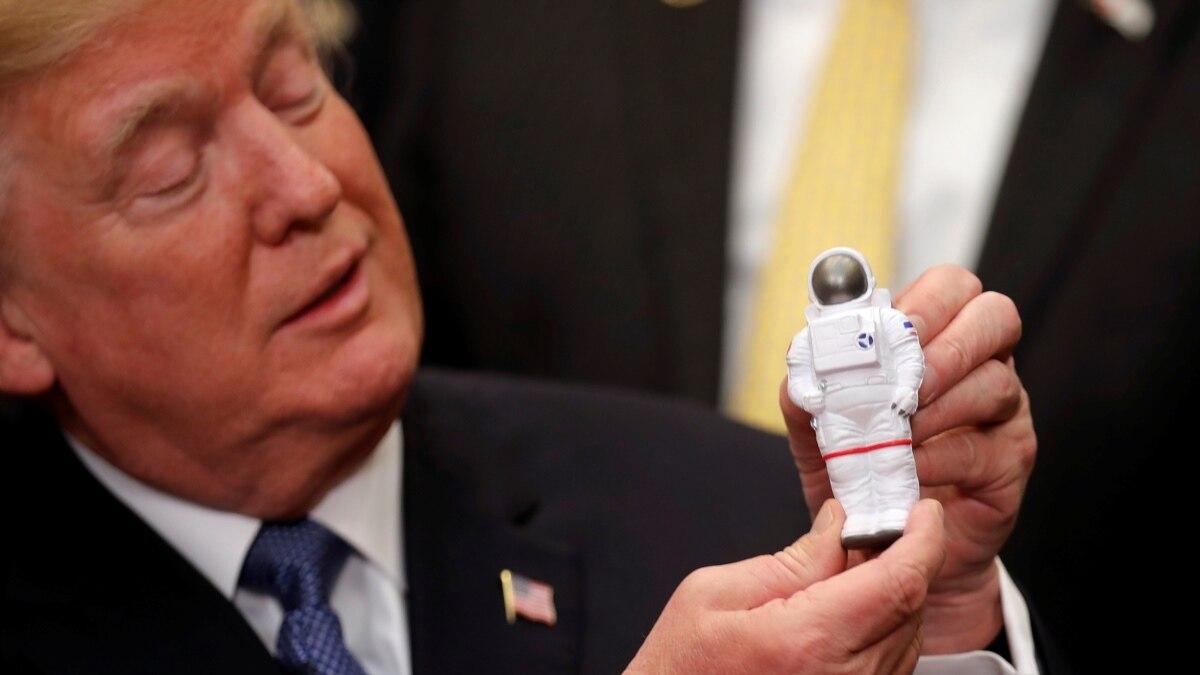
How big is the achievement of the man who landed on the moon?
Shortly before NASA launched the Apollo 11 mission, a letter arrived at its headquarters from the Persian Storytellers Union. The authors asked to change the plan. They were afraid that landing on the moon would deprive the world of dreams, and they would have nothing to do. More painful to mankind's cosmic dreams was probably not the beginning of the flight to the moon, but its sudden end.
The United States fell far behind at the start of the space race. The Soviet Union was the first to launch an artificial Earth satellite into orbit, and then sent the first man beyond the Earth. A month after Yuri Gagarin's flight in April 1961, President John F. Kennedy gave a speech calling on the American people to conquer the moon. (1)
- - He said.
Congress ended up allocating almost 5% of the state budget for NASA activities so that America could "catch up and overtake" the USSR.
The Americans believed that their country was better than the USSR. After all, it was US-flagged scientists who smashed the atom and created the nuclear weapon that ended World War II. However, since the two rival states already possessed huge arsenals and long-range bombers, the USSR's space successes raised fears that it would develop new satellites, larger warheads, space stations, etc., which would endanger the United States. Fear of domination the hostile communist empire was a strong enough incentive to get serious about the space program.
It was also under threat. US international prestige like superpowers. In a global tug-of-war between the free world, led by the US, and the communist countries, led by the USSR, dozens of small developing countries did not know which side to take. In a sense, they were waiting to see who would have a chance to win and then side with the winner. Prestige, as well as economic issues.
All this decided that the American Congress agreed to such colossal expenses. A few years later, even before the Eagle landed, it was already clear that America would win this leg of the space race. However, soon after reaching the lunar goal, the set priorities lost their relevance, and financial resources were reduced. Then they were constantly cut, to 0,5% of the US budget in recent years. From time to time, the agency has put forward many ambitious plans to resume manned flights beyond Earth orbit, but politicians have never been as generous as they were in the 60s.
Only recently have there been signs that the situation may be changing. The basis of the new bold plans is again political, and to a large extent military.
Success two years after the tragedy
July 20, 1969 Eight years after President John F. Kennedy announced a national plan to put a man on the moon by the end of the 60s, US astronauts Neil Armstrong and Edwin "Buzz" Aldrin were the first to land there as part of the Apollo 11 mission. people in history.
About six and a half hours later, Armstrong became the first Homo sapiens to set foot on earth. Taking his first step, he uttered the famous phrase "a small step for man, but a big step for humanity" (2).
2. One of the most famous photographs taken on the Moon by the first astronauts.
The pace of the program was very fast. We admire them especially now as we watch NASA's endless and ever-expanding programs seem much simpler than those pioneering activities. Although the first vision of a moon landing today looks like this (3), already in 1966 - that is, after only five years of work by an international team of scientists and engineers - the agency carried out the first unmanned Apollo mission, testing the structural integrity of the proposed set of launchers and.
3. Model image of the landing on the moon, created by NASA in 1963.
A few months later, on January 27, 1967, a tragedy struck at the Kennedy Space Center at Cape Canaveral in Florida that today would seem to stretch the project out for years. During the manned launches of the Apollo spacecraft and the Saturn rocket, a fire broke out. Three astronauts died - Virgil (Gus) Grissom, Edward H. White and Roger B. Chaffee. In the 60s, five more American astronauts died before their successful flight, but this was not directly related to the preparation of the Apollo program.
It is worth adding that in the same period, at least according to official data, only two Soviet cosmonauts were supposed to die. Only the death was officially announced then Vladimir Komarov - in 1967 during the orbital flight of the Soyuz-1 spacecraft. Earlier, during tests on Earth, Gagarin died before the flight Valentine Bondarienko, but this fact was revealed only in the 80s, and meanwhile, there are still legends about numerous accidents with a fatal outcome of Soviet cosmonauts.
James Oberg he collected them all in his book Space of the Pioneers. Seven cosmonauts were to die before the flight of Yuri Gagarin, one of them, by the name of Ledovsky, already in 1957! Then there should have been more victims, including the death of the second Valentina Tereshkova women in space in 1963. It was reported that after the tragic accident of Apollo 1, American intelligence reported five fatal accidents of Soviet troops in space and six fatalities on Earth. This is not officially confirmed information, but due to the specific "information policy" of the Kremlin, we assume more than we know. We suspect the USSR took the gauntlet in the race, but how many people died before local politicians realized they couldn't outrun the US? Well, this may remain a mystery forever.
"The Eagle Has Landed"
Despite initial setbacks and casualties, the Apollo program continued. In October 1968 Apollo 7, the program's first manned mission, and successfully tested many of the advanced systems needed to fly and land on the moon. In December of the same year, Apollo 8 he launched three astronauts into orbit around the moon, and in March 1969 Apollo 9 The operation of the lunar module was tested in Earth orbit. In May, three astronauts Apollo 10 they took the first complete Apollo around the moon as part of a training mission.
Finally, on July 16, 1969, he took off from the Kennedy Space Center. Apollo 11 (4) with Armstrong, Aldrin and the third, who then waited for them in lunar orbit - Michael Collins. Having traveled 300 76 km in 19 hours, the ship entered the Silver Globe orbit on July 13. The next day, at 46:16 ET, the Eagle lander with Armstrong and Aldrin on board separated from the ship's main module. Two hours later, the Eagle began its descent to the surface of the Moon, and at 17 p.m., touched down on the southwestern edge of the Sea of Peace. Armstrong immediately sent a radio message to Mission Control in Houston, Texas: "The eagle has landed."
4. Apollo 11 rocket launch
At 22:39, Armstrong opened the lunar module hatch. As he descended the module ladder, the ship's television camera recorded his progress and sent out a signal that hundreds of millions of people watched on their televisions. At 22:56 pm, Armstrong stepped down the stairs and put his foot down. Aldrin joined him 19 minutes later, and together they photographed the area, raised the American flag, ran some simple science tests, and spoke to President Richard Nixon via Houston.
By 1:11 am on July 21, both astronauts returned to the lunar module, closing the hatch behind them. They spent the next hours inside, still on the lunar surface. At 13:54 Orzel began to return to the command module. At 17:35 p.m., Armstrong and Aldrin successfully docked the ship, and at 12:56 p.m. on July 22, Apollo 11 began its return journey home, safely entering the Pacific Ocean two days later.
Hours before Aldrin, Armstrong and Collins set off on their mission, several hundred kilometers from where the Eagle landed, it crashed on the moon. Soviet probe Luna-15, as part of a program initiated by the USSR back in 1958. Another expedition was successful - "Luna-16" was the first robotic probe to land on the moon and deliver samples back to Earth. The following Soviet missions placed two lunar rovers on the Silver Globe.
The first expedition of Aldrin, Armstrong and Collins was followed by five more successful lunar landings (5) and one problematic mission - Apollo 13, in which the landing did not take place. The last astronauts to walk on the moon Eugene Cernan and Harrison Schmitt, from the Apollo 17 mission - left the surface of the Moon on December 14, 1972.
5. Landing sites for manned spacecraft in the Apollo program
$7-8 for one dollar
He participated in the Apollo program. about 400 thousand engineers, technicians and scientistsand the total cost should have been $24 billion (nearly $100 billion in today's value); although sometimes the amount is even twice as high. The costs were enormous, but by many accounts the benefits - especially in terms of progress and the transfer of technology to the economy - were greater than we usually imagine. In addition, they continue to meet. The work of NASA engineers at that time had a huge impact on electronics and computer systems. Without R&D and massive government funding at the time, companies like Intel might not have come into being at all, and humanity probably wouldn't be spending so much time on laptops and smartphones, Facebook and Twitter today.
It is common knowledge that the developments of NASA scientists regularly infiltrate products developed in the fields of robotics, computing, aeronautics, transportation, and healthcare. According to Scott Hubbard, who spent twenty years at NASA before becoming a fellow at Stanford University, every dollar the US government puts into the agency's work translates into $7-8 of goods and services being marketed in the long run.
Daniel Lockney, editor-in-chief of Spinoff, NASA's annual publication describing the use of NASA technology in the private sector, acknowledges that the progress made during the Apollo mission has been overwhelming.
“Remarkable discoveries have been made in the fields of science, electronics, aviation and engineering, and rocket technology,” he writes. "This was perhaps one of the greatest engineering and scientific achievements of all time."
Lockney cites several examples related to the Apollo mission in his article. The software designed to control a complex series of systems aboard space capsules was the ancestor of the software currently used in spacecraft. credit card processing equipment in retail. Racing car drivers and firefighters use today liquid-cooled clothing based on devices designed for Apollo astronauts to wear under space suits. Sublimated products designed for Apollo astronauts to be fed in space, it is now used in military field rations known as MREs and as part of emergency gear. And these decisions, after all, are a trifle compared to development of integrated circuit technology and Silicon Valley companies that were very closely associated with the Apollo program.
Jack Kilby (6) from Texas Instruments he built his first working integrated circuit for the US Department of Defense and NASA. According to Lockney, the agency itself determined the required parameters of this technology, adjusting them to its own requirements. She needed lightweight electronics and small computers because mass in space means cost. And based on this specification, Kilby developed his scheme. A few years later he received the Nobel Prize in Physics. Doesn't some of the credit go to the space program?
6. Jack Kilby with the integrated circuit prototype
The Apollo project was politically motivated. However, the policy that first opened the sky trays for him on the US budget was also the reason why he abandoned the lunar program in 1972. The decision to end the program was approved by President Richard Nixon. It has been interpreted in many ways, but the explanation seems to be very simple. America achieved its political goal. And since it was politics, and not science, for example, that mattered most, there was no real reason to continue incurring enormous costs after our goal had been achieved. And after the Americans got their way, it ceased to be politically attractive for the USSR either. For the next decades, no one had the technical or financial ability to take on the moon's challenge.
The theme of power rivalry has only returned in recent years, with the growth of China's capabilities and aspirations. This is again about prestige, as well as about the economy and military aspects. Now the game is about who will be the first to build a stronghold on the Moon, who will begin to extract its wealth, who will be able to create a strategic advantage over rivals on the basis of the Moon.

